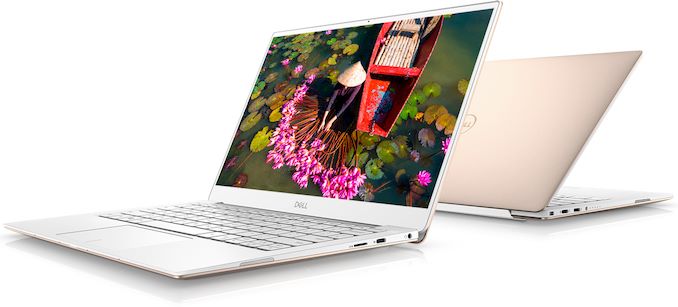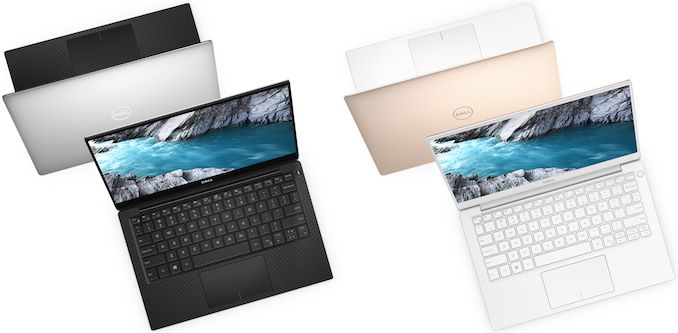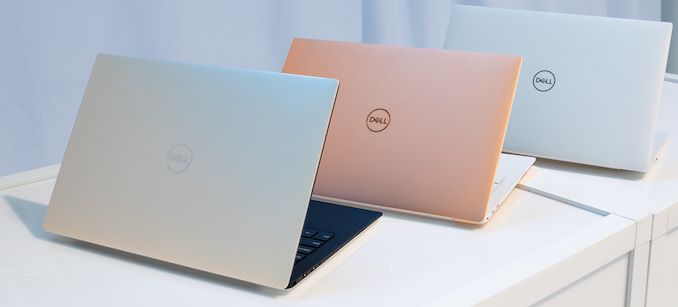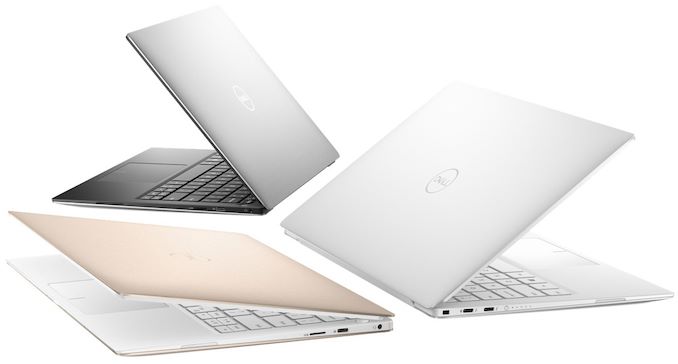Dell Unveils Updated XPS 13 with Intel’s 10th Gen Core CPUs & 4K Panel
by Anton Shilov on August 21, 2019 10:30 AM EST- Posted in
- Notebooks
- Dell
- Intel
- XPS
- Laptops
- XPS 13
- 10th Gen Core
- Comet Lake

Dell has announced its latest-generation XPS 13 laptop based on Intel’s 10th Generation Core "Comet Lake" processors. Initially, Dell’s new 13.3-inch notebooks will come with quad-core CPUs, but starting from October the company will also offer the laptop with Intel's top-end hex core model.
Being one of the most popular 13.3-inch notebooks on the market, the XPS 13 has a long history of evolution. The 2019 XPS 13 model 7390 has been completely redesigned both inside and outside. The new machines come in a CNC-machined aluminum chassis with a carbon fiber composite or woven glass fiber palm rest, so they look considerably different than their predecessors. Among other things, key peculiarities of the new XPS 13 are its thickness and low weight. The PCs feature a 7.8 – 11.6 mm z-height and weight of around 1.16 – 1.23 kilograms depending on the model, so the new laptops are among the thinnest and lightest 13.3-inch notebooks on the market.
The new XPS 13 latops are equipped with a 13.3-inch LCD panel with thin InfinityEdge bezels as well as an 80.7% screen to body ratio. The display panels feature a 1920×1080 or 3840×2160 resolution, 400 nits brightness, a 1500:1 contrast ratio as well as Dolby Vision support on select SKUs.
The latest Dell XPS 13 computers are based on Intel’s 10th Gen Core i3/i5/i7 Comet Lake-U processors. The CPUs are cooled down using a brand-new cooling system that relies on two fans, an ultra-thin vapor chamber, and GORE thermal insulation to ensure stable performance even under high loads.
The XPS 13 systems can be equipped with up to 16 GB of soldered-down DRAM as well as a PCIe SSD up to 2TB in size. When it comes to connectivity, the XPS 13 7390-series features a Killer AX1650 Wi-Fi 6 + Bluetooth 5 controller, two Thunderbolt 3 ports, a microSD card reader, a 3.5-mm jack for headsets, and other options. As for multimedia multimedia capabilities, the new laptop has two 2 W speakers co-designed with Waves MaxxAudio, a far-field Cortana-capable microphone array, and a newly designed 2.25-mm 720p webcam located on top of the display lid.
Dell says that the XPS 13 notebook is equipped with a 52 Wh battery that can enable operation for up to 19 hours on one charge (based on the Mobile Mark 2014 benchmark), but the real-world battery life is something that remains to be seen.
When it comes to availability, Dell’s new XPS 13 with quad-core CPUs will be available starting August 27 at $899.99.
| Specifications of the Dell XPS 13 7390 | |||
| General Specifications | |||
| LCD | Diagonal | 13.3-inch | |
| Resolution | 1920×1080 | 3840×2160 | |
| Brightness | 400 cd/m² | ||
| Contrast Ratio | 1500:1 | 1500:1 | |
| Color Gamut | 100% sRGB | 100% sRGB | |
| Features | Dolby Vision | Dolby Vision | |
| Touch Support | with or without touch | Yes | |
| Protective Glass | Corning Gorilla Glass 4 | ||
| CPU | Intel’s 10th Gen Core i3 Intel’s 10th Gen Core i5 Intel’s 10th Gen Core i7 |
||
| Graphics | Intel's UHD Graphics | ||
| RAM | 4 - 16 GB LPDDR3 DRAM (onboard) | ||
| Storage | 128 GB PCIe 3.0 x2 SSD 256 GB PCIe 3.0 x4 SSD 512 GB PCIe 3.0 x4 SSD 1 TB PCIe 3.0 x4 SSD 2 TB PCIe 3.0 x4 SSD |
||
| Wireless | Killer AX1650 Wi-Fi 6 + Bluetooth 5.0 (based on Intel's silicon) | ||
| USB | 3.1 | 2 × TB 3/USB Gen 3.1 Gen 2 Type-C | |
| 3.0 | - | ||
| Thunderbolt | 2 × TB 3 (for data, charging, DP displays) | ||
| Cameras | Front | 720p HD webcam | |
| Other I/O | Microphone, 2 stereo speakers, audio jack | ||
| Battery | 52 Wh | ||
| Dimensions | Width | 302 mm | 11.9 inches | |
| Depth | 199 mm | 7.8 inches | ||
| Thickness | 7.8 - 11.6 mm | 0.3 - 0.46 inches | ||
| Weight | non-touch 1.16 kilograms | 2.6 pounds touch-enabled 1.23 kilograms | 2.7 pounds |
||
| Launch Price | Starting at $899 | ||
Related Reading:
- The Ice Lake Benchmark Preview: Inside Intel's 10nm
- Dell’s XPS 13 2-in-1 7390 Available: Intel’s 10th Gen Core CPUs Inside
- Dell Launches XPS 15 7590: Up to 5 GHz and Overclockable, 15.6-Inch OLED
- When Ice Matters: Dell Announces XPS 13 2-in-1 with Ice Lake-U
Source: Dell















42 Comments
View All Comments
jeremyshaw - Wednesday, August 21, 2019 - link
Is this using the same 13.4" 16:10 panels from the XPS 13 7390 2in1, or is it using a new, 13.3" 16:10 panel? Also, given one of Comet Lake - U's main achievements is LPDDR4 support, is Dell seriously still sticking to LPDDR3?znd125 - Wednesday, August 21, 2019 - link
Might be a typo. Notebookcheck is reporting the same 1080p resolution as before.https://www.notebookcheck.net/Dell-XPS-13-7390-wil...
brakdoo - Wednesday, August 21, 2019 - link
Yeah and the first pic here looks more like 16:9 than 16:10. At least I hope it's 16:9 because watching movies or apps using side menus (like Visual Studio or Adobe stuff) is so much better.ajp_anton - Wednesday, August 21, 2019 - link
What's wrong with some extra vertical space? It's pretty much the same width anyway, both in terms of pixels and physical size, only difference is that 16:9 has a huge bezel at the bottom that could be used for more screen.brakdoo - Wednesday, August 21, 2019 - link
The bezels could be cut away if you don't need them..-Or just buy a nice 14 inch laptop if you want vertical space.
Horizontal space is much more important nowadays because people do less stuff that would benefit from additional vertical pixels (like typing letters or destop publishing).
ajp_anton - Wednesday, August 21, 2019 - link
So again, what's wrong with 16:10 when the horizontal space is the same, but you get more vertical space?oRAirwolf - Thursday, August 22, 2019 - link
There is nothing wrong with it. People like to reee about black bars when watching 16:9 content and have no idea what they are losing in the process. Microsoft, Huawei, and Apple (even Dell) have all figured it out. 16:10 or 3:2 is a much more efficient use of space and is much more useful for browsing pages, content creation, and productivity.Ej24 - Wednesday, August 21, 2019 - link
Computers don't care about inches. The UI scaling is based on pixels. So if a window is 800 pixels high on a 13in 1080p screen it will take up proportionally the exact same amount of space on a 14in 1080p screen. I never understood how people don't get this. There's zero difference between a 40in 1080p display and a 13in 1080p display. If they're both set to 100% scaling (Windows doesn't go below 100% scaling) they'll have exactly the same amount of screen real estate to work with.dontlistentome - Thursday, August 22, 2019 - link
14" just means bigger pixels. 16:10 means more space. You've obviously never used a 16:10 screen. They are *awesome*. Some people do more than watch 16:9 videos on their devices...Ej24 - Wednesday, August 21, 2019 - link
Definitely still has a massive chin. Completely wasted space. Really disappointing. The footprint of this laptop would probably even allow a 3:2 display. But instead we get a useless chin.